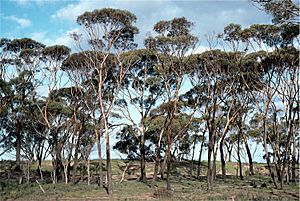Kondinin blackbutt facts for kids
Quick facts for kids Kondinin blackbutt |
|
|---|---|
 |
|
| Eucalyptus kondininensis near Lake Grace | |
| Scientific classification | |
| Genus: |
Eucalyptus
|
| Species: |
kondininensis
|
The Kondinin blackbutt (Eucalyptus kondininensis) is a special type of tree. It only grows in Western Australia. This tree is known for its rough, black bark on the main trunk. Higher up, its branches have smooth, grey, or white bark. It has long, narrow leaves, white flowers that grow in groups of seven, and fruit shaped like a cup or cone.
Contents
About the Kondinin Blackbutt
The Kondinin blackbutt tree usually grows to be about 4 to 20 meters (13 to 66 feet) tall. Most of these trees have a special woody swelling at their base called a lignotuber. This helps the tree regrow if it gets damaged, for example, by a bushfire. Some trees, however, don't have this lignotuber and are called "mallets."
The bark on the lower half of the trunk is rough, hard, black, and flaky. The bark higher up is smooth and can be grey or white.
Leaves and Flowers
Young Kondinin blackbutt plants have stems that are somewhat square. Their leaves are long and narrow, about 55 to 80 mm (2.2 to 3.1 inches) long and 10 to 15 mm (0.39 to 0.59 inches) wide.
Adult leaves are arranged in an alternating pattern along the stem. They are shiny green and shaped like a spear. These leaves are about 60 to 117 mm (2.4 to 4.6 inches) long and 6 to 12 mm (0.24 to 0.47 inches) wide. They narrow down to a stalk called a petiole, which is about 10 to 20 mm (0.39 to 0.79 inches) long.
The tree's flower buds grow in groups of seven. They are found where the leaves meet the stem. These buds are mostly attached directly to a stalk that is 5 to 14 mm (0.20 to 0.55 inches) long. The Kondinin blackbutt flowers are white and bloom between December and July.
Fruit and Seeds
After flowering, the tree produces woody fruit. These fruits are shaped like a cup or cone. They are about 4 to 6 mm (0.16 to 0.24 inches) long and 4 to 7 mm (0.16 to 0.28 inches) wide. Inside, the seeds are shiny, reddish-brown, and flattened oval. They are very small, only about 0.8 to 2 mm (0.031 to 0.079 inches) long.
How it Was Named
The Kondinin blackbutt was first officially described in 1925. Two botanists, Joseph Maiden and William Blakely, gave it its scientific name, Eucalyptus kondininensis. They published their description in the Journal and Proceedings of the Royal Society of New South Wales.
The name kondininensis comes from the town of Kondinin. This is an area in Western Australia where this tree is commonly found.
Where it Grows
The Kondinin blackbutt grows in inland parts of the Wheatbelt and Goldfields-Esperance regions of Western Australia. You can find it on rocky hills, on flat areas near salt lakes, and around the salt lakes themselves. It prefers loamy-sandy-clay soils that are found over a type of rock called laterite.
This tree is spread out across a wide area. It can be found from Pingelly in the west to Ravensthorpe in the east. Its range also stretches from Lake King in the north to Nyabing in the south.
Its Habitat
The Kondinin blackbutt lives in open woodland areas. It is often one of the taller trees in these places. It grows alongside other types of eucalyptus trees, such as the Red morrel (Eucalyptus longicornis), Eucalyptus urna, Salt River gum (E. sargentii), and Salmon gum (E. salmonophloia).
Smaller plants and shrubs grow beneath these trees. Some of these include different types of Melaleuca plants like Melaleuca lateriflora, M. acuminata, and M. thyoides. Other plants found in the undergrowth are various saltbushes like Atriplex paludosa and Atriplex vesicaria, as well as Acacia erinacea and Disphyma crassifolium.
Conservation Status
The Western Australian Government's Department of Parks and Wildlife has classified the Kondinin blackbutt as "not threatened." This means it is not currently at risk of disappearing.
Images for kids




